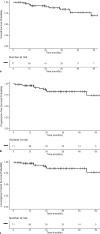Unilateral Neck Treatment with either Surgery and/or Radiotherapy for Squamous Cell Carcinoma for the Tonsil
- PMID: 39265554
- PMCID: PMC11651319
- DOI: 10.1159/000541390
Unilateral Neck Treatment with either Surgery and/or Radiotherapy for Squamous Cell Carcinoma for the Tonsil
Abstract
Introduction: Strategies for treatment of tonsil carcinoma are under active investigation. Limiting surgical and radiation treatment volumes to the primary tumor and ipsilateral neck in appropriately selected patients are one such approach. Here, we present our institutional experience with treatment through ipsilateral surgical or radiotherapeutic neck management.
Methods: We retrospectively reviewed our institutional database of patients with tonsil carcinoma treated from 2012 to 2020. Patients were included for analysis if they received definitive radiation therapy (RT), definitive surgery (S), or surgery with postoperative radiation therapy (S-PORT) and whose treatment volumes were limited to the primary tumor and involved/elective ipsilateral neck. Patients who received radiation and/or surgery to the contralateral neck (including those with bilateral nodal involvement), as well as patients with metastatic disease, were excluded. Clinical factors including T- and N-stage (AJCC 7th edition), and HPV status (by p16 and/or HPV DNA PCR) were recorded, as were pathologic factors (when applicable) including margin status, extracapsular extension (ECE), lymphovascular invasion (LVSI), and perineural invasion (PNI). Overall survival (OS), progression-free survival (PFS), and locoregional control (LRC) at 2 years were estimated using the Kaplan-Meier method.
Results: In total, 71 patients were treated with unilateral neck approaches: S (n = 49), RT (n = 10), and S+PORT (n = 12). Among these patients, 32, 36, and 3 had T1, T2, and T3 disease, respectively. N-stage was N0, N1, N2a, N2b, and N3 in 22, 20, 5, 23, and 1 patient(s), respectively. Concurrent chemotherapy was administered in 12 patients. From those with recorded risk factors, 86% were HPV positive, 20% had LVSI, 7% had PNI, 13% had ECE, and 5% had positive margins. From a median follow-up of 27 months, local, regional, and distant failures occurred in 5, 6, and 5 patients, respectively. No contralateral neck failures were recorded. At 2 years, OS, PFS, and LRC were 92% (95% CI 85-99%), 85% (95% CI 75-95%), and 88% (95% CI 80-98%), respectively.
Conclusions: In patients with early T-stage tonsil carcinoma, treatment of the primary tumor and ipsilateral neck is associated with acceptable OS, PFS, and LRC. In this population, the risk of contralateral neck failure is likely very low regardless of primary treatment modality. Additional prospective studies are needed to determine the impact of limiting treatment extent, either surgical or radiotherapeutic, to the unilateral neck.
Keywords: Radiation; Surgery; Tonsil; Unilateral.
© 2024 The Author(s). Published by S. Karger AG, Basel.
Conflict of interest statement
The authors do not report any conflicts of interest related to this work.
Figures
Similar articles
-
Treatment Outcomes and Patterns of Disease Recurrence of Patients with Carcinoma of the Buccal Mucosa.Indian J Otolaryngol Head Neck Surg. 2024 Dec;76(6):5209-5220. doi: 10.1007/s12070-024-04948-6. Epub 2024 Aug 30. Indian J Otolaryngol Head Neck Surg. 2024. PMID: 39559099
-
Comparison of Two Modern Survival Prediction Tools, SORG-MLA and METSSS, in Patients With Symptomatic Long-bone Metastases Who Underwent Local Treatment With Surgery Followed by Radiotherapy and With Radiotherapy Alone.Clin Orthop Relat Res. 2024 Dec 1;482(12):2193-2208. doi: 10.1097/CORR.0000000000003185. Epub 2024 Jul 23. Clin Orthop Relat Res. 2024. PMID: 39051924
-
Minimally invasive surgery versus radiotherapy/chemoradiotherapy for small-volume primary oropharyngeal carcinoma.Cochrane Database Syst Rev. 2016 Dec 11;12(12):CD010963. doi: 10.1002/14651858.CD010963.pub2. Cochrane Database Syst Rev. 2016. PMID: 27943254 Free PMC article.
-
Optimisation of chemotherapy and radiotherapy for untreated Hodgkin lymphoma patients with respect to second malignant neoplasms, overall and progression-free survival: individual participant data analysis.Cochrane Database Syst Rev. 2017 Sep 13;9(9):CD008814. doi: 10.1002/14651858.CD008814.pub2. Cochrane Database Syst Rev. 2017. PMID: 28901021 Free PMC article.
-
Signs and symptoms to determine if a patient presenting in primary care or hospital outpatient settings has COVID-19.Cochrane Database Syst Rev. 2022 May 20;5(5):CD013665. doi: 10.1002/14651858.CD013665.pub3. Cochrane Database Syst Rev. 2022. PMID: 35593186 Free PMC article.
References
-
- Perez CA, Purdy JA, Breaux SR, Ogura JH, von Essen S. Carcinoma of the tonsillar fossa: a nonrandomized comparison of preoperative radiation and surgery or irradiation alone: long-term results. Cancer. 1982;50(11):2314–22. - PubMed
-
- Perez CA, Patel MM, Chao KS, Simpson JR, Sessions D, Spector GJ, et al. . Carcinoma of the tonsillar fossa: prognostic factors and long-term therapy outcome. Int J Radiat Oncol Biol Phys. 1998;42(5):1077–84. - PubMed
-
- Lim YC, Koo BS, Lee JS, Lim JY, Choi EC. Distributions of cervical lymph node metastases in oropharyngeal carcinoma: therapeutic implications for the N0 neck. Laryngoscope. 2006;116(7):1148–52. - PubMed
-
- Jackson SM, Hay JH, Flores AD, Weir L, Wong FL, Schwindt C, et al. . Cancer of the tonsil: the results of ipsilateral radiation treatment. Radiother Oncol. 1999;51(2):123–8. - PubMed
MeSH terms
LinkOut - more resources
Full Text Sources


